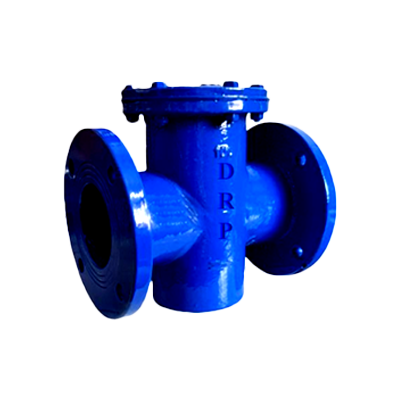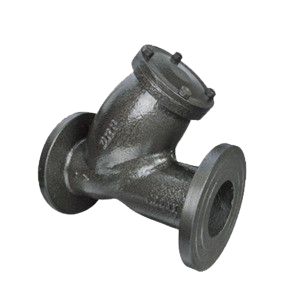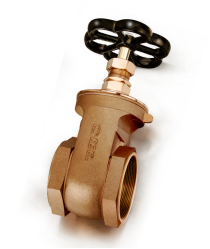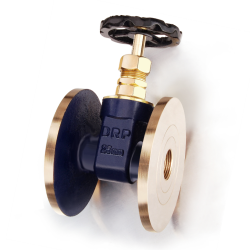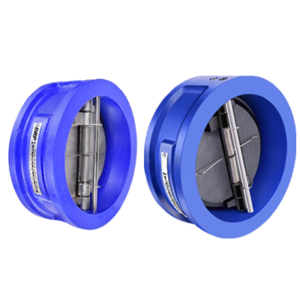CAST IRON T-TYPE STRAINER FLANGED
A T-type (or tee-type) strainer is a pipeline filter device shaped like the letter “T”. It has a main flow path and a perpendicular branch that houses a removable screen or perforated basket/basket-element to trap particles. The fluid flows through the screen; debris is retained and periodically removed by cleaning the screen. They are also sometimes called “bath tub” strainers in some regions. Indusrtrial Valve Manufacturer+2tecmara.com+2
Typical Specifications
Here are the typical design/specification parameters one sees in T-type strainers:
| Parameter | Typical Values / Options |
|---|---|
| Size (Nominal Pipe Size / DN) | From small sizes like ½″ up to very large (e.g. 48″ or more in some manufacturers) depending on capacity. Pargreen Process Technologies+2tecmara.com+2 |
| Pressure Rating / Class | ANSI / ASME classes: 150#, 300#, 600#, sometimes up to 900# or higher (depending on material and manufacturer). Some strainers also made to high pressure (e.g. 2500 lb) rating. Aitken+3tecmara.com+3Quality Wire+3 |
| Material of Construction | Carbon steel, stainless steel (304, 316, etc.), alloy steels (chrome-moly, etc.), sometimes special alloys (Monel, duplex, etc.) for corrosive media. Aitken+2Quality Wire+2 |
| Screen / Filter Element | Perforated plates, wire mesh, various mesh counts, perforation sizes. Screen types: W-design (large surface, convoluted), V-design, etc. Hole sizes/perforations from coarse to fine depending on application. Pargreen Process Technologies+2tecmara.com+2 |
| Orientation / Installation | Can be installed in horizontal or vertical pipelines. Flow direction may be straight (through the run), or involve right-angle flows. Access for cleaning via covers (bolted or quick-opening) or sometimes hinged covers. Indusrtrial Valve Manufacturer+2Pargreen Process Technologies+2 |
| Codes & Standards | ASME B16.34 (valves & fittings), ASME B31.3 / B31.1 for piping, ASME Section VIII when vessel-type requirements apply; also standard flange/rating specifications (ANSI, ASME). Indusrtrial Valve Manufacturer+2Aitken+2 |
| Temperature / Corrosion Capability | Depends on material; stainless steel/alloys allow corrosive fluids, high temperature; carbon steel for less aggressive fluids; optional coatings, linings, or special materials for harsh service. tecmara.com+1 |
Classification / Types
T-type strainers can be classified in a number of ways:
-
By Flow Path / Configuration:
-
Straight flow (fluid flows straight through the run with branch containing straining element) Indusrtrial Valve Manufacturer+1
-
Right-angled flow (in-to-out or out-to-in) where flow may enter/exit via the branch or run at a 90° angle. Indusrtrial Valve Manufacturer+1
-
Bi-directional or modified designs allowing reverse flow, or dual runner bars, etc. Aitken
-
-
By Cover / Access Type:
-
Bolted covers (standard) Pargreen Process Technologies+1
-
Quick-opening / swing-bolt / hinged covers (for frequent maintenance) Pargreen Process Technologies+1
-
Davit or lifting devices for large heavy covers Aitken+1
-
-
By Material:
-
Carbon steel vs Stainless vs Special alloys for corrosion / temperature. tecmara.com+1
-
-
By Pressure / Class Rating:
-
Standard pressure classes (ANSI 150, 300, 600 etc.). Pargreen Process Technologies+1
-
High pressure versions (up to 2500 lb) in certain applications. tecmara.com
-
-
By Mesh / Filtration Level:
-
Coarse vs fine screening depending on the particle size to remove. Mesh count or perforation size controls this. Pargreen Process Technologies+1
-
Typical Uses & Industries
T-Type strainers are used wherever there is a need to protect downstream equipment from solid debris, especially where flow rates/pipe sizes are relatively large, or where frequent maintenance access is desired. Some specific applications/industries:
-
Water treatment & supply — removing sand, rust, debris from raw water, pre-filtration, protecting pumps and other equipment. Flometriq+2DERVOS VALVE CO.,LTD+2
-
Power generation — boiler feed water, condensate, cooling water, steam systems. Pargreen Process Technologies+2Flometriq+2
-
Oil & Gas / Petrochemical / Chemical plants — process fluids, protecting valves, heat exchangers, pumps; handling corrosive or high-temperature media as required. Indusrtrial Valve Manufacturer+2DERVOS VALVE CO.,LTD+2
-
Refineries — in many parts of the refining process, removing solids or particulates that might damage downstream equipment. GMK+1
-
Industrial cooling / condensate / HVAC systems — often where water quality is good but protection from occasional debris is needed, and low pressure drop is important. Pargreen Process Technologies+1
-
General process industries — pulp & paper, food and beverages (if hygienic versions are used), mining, etc. Also gas pipelines, compressed air systems. DERVOS VALVE CO.,LTD+1
Pros (Advantages)
T-type strainers offer several benefits. Key ones include:
-
High Capacity / Larger Straining Area
The “T” shape with a sizable branch allows a larger screen or basket compared to some other strainer designs (for the same run-size), so they can hold more debris before becoming plugged. Pargreen Process Technologies+1 -
Low Pressure Drop (if sized well)
Because of the large open area of screen, and designs that allow straight flow, pressure losses can be modest. Special designs (e.g. convoluted screens) further reduce pressure drop and extend intervals between cleanings. Pargreen Process Technologies -
Versatile Installation
Can be installed horizontal or vertical, and adapted to flow direction. Good for tight spaces in some cases. Indusrtrial Valve Manufacturer+1 -
Ease of Maintenance
Screens/baskets are removable; many designs have quick-open covers or hinged lids, differential pressure taps to monitor clogging. Some designs also allow cleaning without draining the whole pipeline. Pargreen Process Technologies+1 -
Material Flexibility
Many materials are possible, so can be used in corrosive or high temperature environments. Aitken+1 -
Cost-Effectiveness for Large Bores
For large pipe sizes and coarse filtration (not ultra-fine), T-types are often simpler and cheaper than more complex strainer or filter systems. Indusrtrial Valve Manufacturer+1
Cons (Disadvantages / Limitations)
Of course there are trade-offs. Here are principal drawbacks of T-type strainers:
-
Large Size / Weight
For large sizes, the branch containing the screen adds thickness; covers can be heavy. Requires support and sufficient room to open covers. Pargreen Process Technologies+1 -
Space Requirements for Cleaning Access
Need enough space (especially above or to the side) to remove basket/screen; quick-open or hinged covers help, but still some clearance needed. Pargreen Process Technologies+1 -
Potential for Higher Pressure Drop if Screen is Fine / Clogged
If mesh is fine and gets clogged, pressure drop increases significantly; requires regular monitoring/maintenance. Also, screen design (if inefficient or compressed) may increase losses. Fil-Trek+1 -
Not Suitable for Ultra-Fine Filtration
For very fine particle removal (very small microns), or where continuous filtration or self-cleaning is needed, other types (e.g. filters, strainers with back-wash, duplex etc.) may be better. Flometriq+1 -
Flow Direction Sensitivity
Some designs have higher pressure drop or stress depending on how fluid enters/exits the run and branch. Also sealing / gaskets etc must be properly done. Indusrtrial Valve Manufacturer -
Maintenance Downtime
Even with quick open covers, the strainer must be cleaned/replaced periodically; in some systems this requires shutdown unless bypass/duplication is provided. Pargreen Process Technologies
Key Performance / Design Considerations
When designing or selecting T-type strainers, to get good performance, engineers typically consider:
-
Mesh / Perforation size: what particle size to remove. Too fine wastes pressure; too coarse allows unwanted debris.
-
Free area ratio (open screen area vs pipe area) — larger free area reduces velocity through screen, reducing pressure drop.
-
Flow rates and velocities: ensure that velocities through screen are not so high that forces damage the screen, or that turbulence/erosion becomes a problem.
-
Differential pressure taps: to monitor how “dirty” the strainer is.
-
Access clearances for cleaning and cover types.
-
Material compatibility with fluid (corrosion, temperature).
-
Pressure rating and design code compliance.
